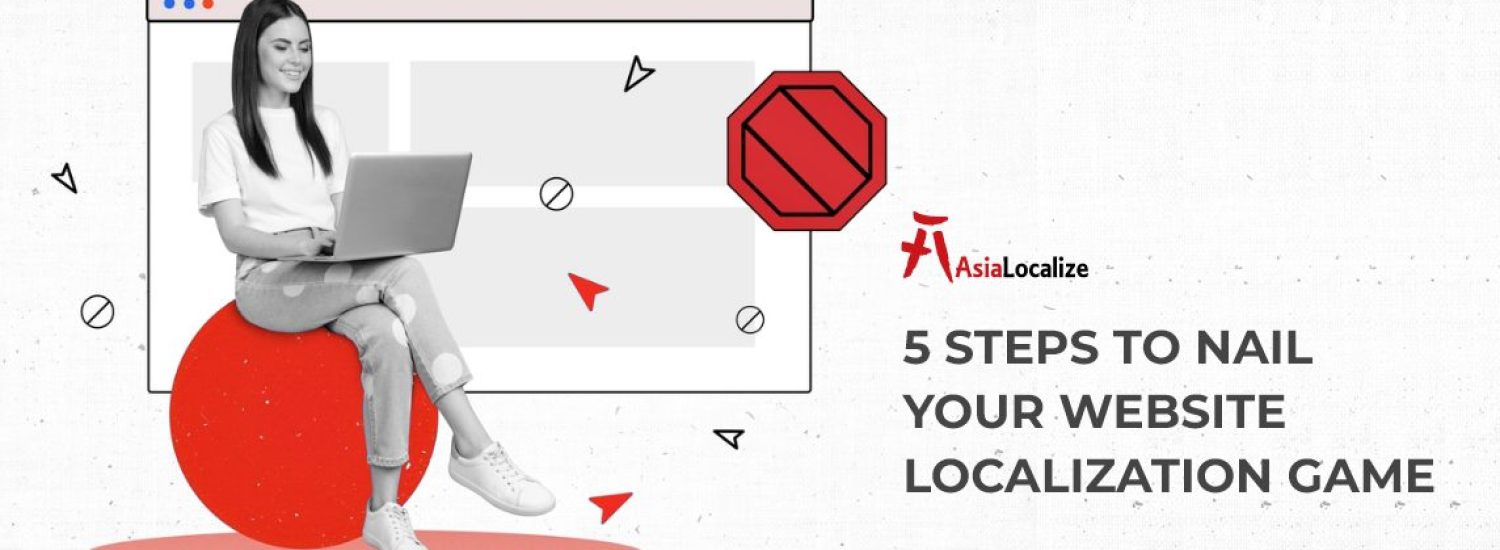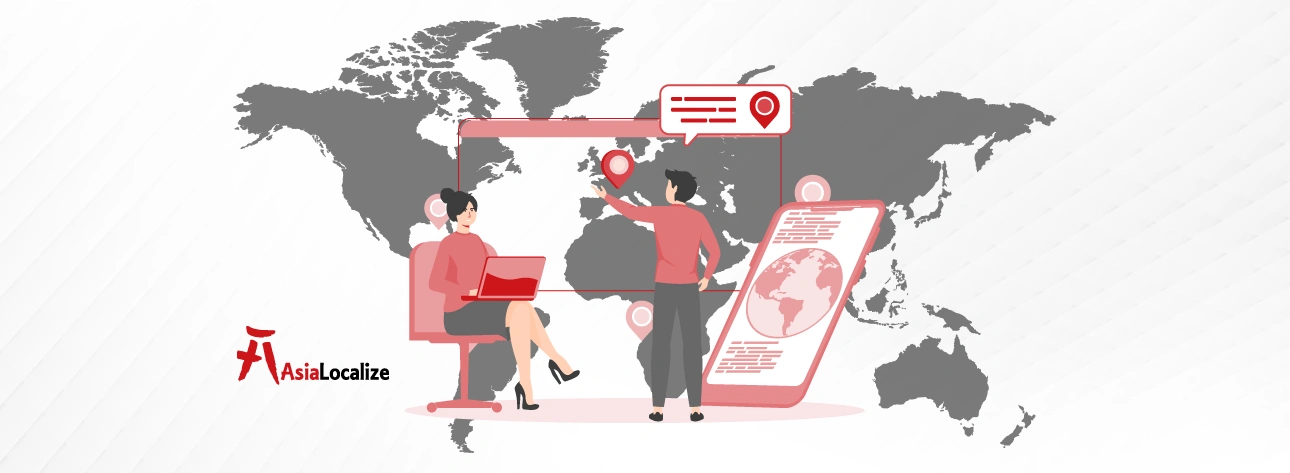You are reading this because you probably know that an online presence isn’t enough for your business to engage and convert customers in foreign markets. You must have also heard about website localization as a crucial element in your global business strategy. And chances are that you believe that website localization is daunting.
But here’s the thing, it only takes the right process and a dose of patience to get it done. It’s like climbing a mountain – tough, but doable if you take it step by step.
That’s why we have dedicated this blog to spelling out 5 key steps you can adopt to launch your business multilingual website that drives more customers and ROI across different markets
What You Need to Know About Website Localization: Airbnb Case Study
Airbnb, the American online marketplace for short- and long-term homestays and experiences, the largest in the travel industry, is a case in point. The company started its localization journey with a clear growth strategy and a solid approach, through which it has been able to drive market expansion and return on investment (ROI).
Today, Airbnb ranks #2 among the top 25 global companies, after Wikipedia, according to the 2024 Web Globalization Report Card.
How, you may ask? Localization.
Airbnb is active in over 200 countries and 100,000 cities, with more than 7 million active listings as of September 2023, the highest ever. In order to cater to this global audience,
Airbnb invested in localization. The Airbnb team understood the assignment. They managed to build multilingual websites that provide authentic, personalized experiences in around 62 languages and dialects for their target markets.
Is Multilingual Synonymous with Localization?
Yes and no.
Yes, because a huge part of localization is language translation.
While English is the most spoken language, 18% of the global population speaks English. If your business’ home market is a non-English-speaking country, the necessity to translate your website becomes even more pronounced.
Besides, non-English-speaking visitors tend to spend twice as much time on localized websites. And they are four times more likely to make a purchase from businesses that communicate in their native language.
Despite being an American brand, Airbnb realized English wouldn’t be enough to achieve its expansion ambitions. They “translated” their website into multiple languages for better accessibility to non-English speakers. This translation includes every text on their website including:
- Navigation Menus: Services, bookings, products, contact, etc.
- Page Titles and Headings
- Listing Descriptions
- Call-to-Action (CTA) Buttons
- Forms
- Newsroom (blogs and articles)
- User-Generated Content (UGC)
- Terms and Conditions: Help center, privacy policies, etc.
- Error Messages
So, why multilingual isn’t synonymous with localization? Because localization involves much more than translation.
Localization Is All About the User Experience
While your website translation is crucial to your users’ experience, it’s not the only aspect. Sure, it’s good if they understand what your brand is and what you are offering. But it’s even better if you provide an experience that feels like home through a website that feels and looks local.
Airbnb knows the exact difference between translation and localization. They understand that website localization isn’t about transferring their content from one language to another but a profound adaptation of the website to resonate with their audience’s local cultural nuances and legal regulations.
Airbnb went into localization all in. You’ve got a platform that customizes its structure and content as well as the technical, visual, and legal elements. The whole website is personalized, adjusted to the local audience. Here’s a breakdown of what Airbnb website localization includes:
- Layout and Design to accommodate different languages’ text lengths and reading directions. For example, languages that read from right to left, such as Arabic and Hebrew.
- Visual Identity: Images, graphics, colors, and symbols to align with local customs and traditions.
- Technical Considerations: Character sets, encoding formats, date and time formats to match local conventions.
- User Interface (UI) and User Experience (UX): Buttons, menus, forms, and other UI elements are intuitive and culturally appropriate for seamless navigation.
- Currency and Payment Methods: Adapting the website to display prices in the local currency and offering payment methods that are commonly used and trusted in the target market.
You can see this in the Experiences section, where they feature relevant must-see places, restaurants, and local tips. They even go the extra mile, enlisting the help of local content providers and photographers to offer their target community a 360-degree experience that is both authentic and familiar.

It’s easy to assume that website localization is a simple one-step process. But, in reality, it’s a more multi-layered adaptation process to better suit a new market different from the one it was initially built for.
“At Airbnb, we define localization as deliberately creating products and services that are culturally appropriate, locally relevant, and globally consistent at scale.”
Salvo Giammarresi – the Head of Localization at Airbnb
5 Steps for Your Website Localization
Here are 5 steps to nail your website localization and impress your target audience.
1. Research Your Target Market
There’s no such thing as too much research.
First off, conducting market research will help you determine whether your products/services have the potential to succeed in a particular market or not.
Without understanding your target audience, you won’t be able to tailor your website to their needs and preferences, which means losing users and opportunities.
It’s with research that Airbnb knew that cash payments are more common in Asian markets, so they introduced cash payment to accommodate local expectations, removing a significant barrier for potential customers and making its services more accessible.
Plus, cultural sensitivity is no joke. Slight oversights damage brands. You’ll need to identify social norms, values, customs, and traditions that may influence consumer behavior and preferences to ensure cultural relevance in your localized content and messaging.
Forget guesswork. An in-depth market research should identify your target market’s needs and pain points, purchasing habits, and preferred payment methods, as well as the strengths and weaknesses of your local competition.
2. Automate the Localization Process
This is 2024! You don’t expect to go about website localization in an old-fashioned, manual way. Imagine the time and resources wasted on repetitive tasks. The key to efficient and successful website localization lies in automation.
With cloud-based platforms and integrated translation management systems (TMS), large teams from different corners of the world can work together seamlessly. These tools optimize the localization workflow, with features like Content Management System (CMS) integration and CAT tools integration, which help accelerate the process by reusing previously translated segments, the way it has for Airbnb.
And then, there’s machine translation. Machine translation (MT) has come a long way, offering surprisingly accurate base translations. These translation engines can indeed handle large volumes of content. However, you don’t want speed and scale to compromise quality, so you’ll need to leverage MT in conjunction with human post-editing.
Key Translation Tools to Automate Your Website Localization
Content Management Systems
Translation Management Systems
Translation Memories
Quality Assurance Tools
Machine Translation
Terminology Management Tools
3. Conduct A Thorough Keyword Research
Without relevant keywords, your website is invisible to search engines – and your target audience.
Keyword research helps you identify relevant keywords with sufficient search volume in your target market and discover what your audience is actively looking for.
Never assume a new market will have the same search behavior as your home country. People in different regions might search for the same thing using entirely different terms.
Even within English-speaking countries, there can be differences in terminology and word usage. For example, while British speakers use “holiday,” Americans use “vacation.” So, simply translating your existing keywords won’t suffice.
4. Design A Perfect Language Selector
When catering to multiple languages, a user-friendly language selector is a must. You don’t want potential customers to abandon your site due to complex navigation. A responsive and easy-to-find language selector is key to keeping your audience engaged.
Design a language selector that is responsive, adaptable, and easy to find with clear labels and intuitive icons. Preferably, autodetection software should be used to detect the visitor’s language based on their IP address.
5. Never Leave Anything Behind
Remember, it is the whole experience! Every element, from text to visuals, contributes to the overall impression, and neglecting any aspect can create a disconnect.
Did you know that 91% of consumers prefer visuals over text? In fact, people tend to remember 10% of what they read and 65% of what they see. If you aren’t localizing your website’s visual content, you’re missing out on a powerful user experience aspect.
Alt text matters. Although it may seem unnecessary for many to localize it, Google and other popular search engines use Alt Text to understand what the image is linked to and its purpose, which contributes directly to better ranking.
Even colors can be your greatest asset or your worst liability in a new market. Colors can have surprisingly deep cultural meanings. Red might symbolize good luck in China but danger in some European countries. Understanding these nuances and adapting your color scheme accordingly helps avoid unintentional offense.
Take a look at KFC’s websites in China and Egypt to see for yourself the stark differences between them and the way they tackle their audiences:

Final Thoughts
Localizing a website for a new market can significantly impact the success of your global business. However, yes, it can be a bit daunting. It’s cross-disciplinary and there are several stakeholders involved, from professional translators and developers to graphic designers and QA engineers. That’s why partnering with a professional website localization company can make the process much easier and less overwhelming.
A reputable website localization company manages the entire process, assembling the localization team and necessary tools to make everything smooth and ensure a swift turnaround.
At AsiaLocalize, as an expert language services provider, we specialize in helping businesses reach their potential in new markets, directing them to the right path to communicate with their target audiences effectively. With our end-to-end website localization services, you will be able to slog through your target market in the quickest turnarounds.






